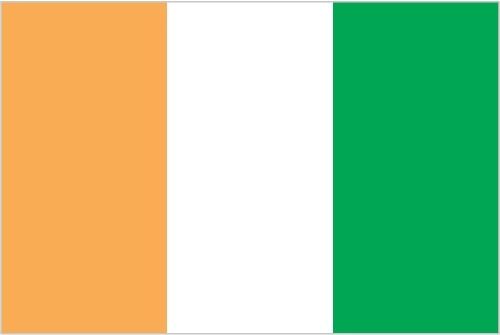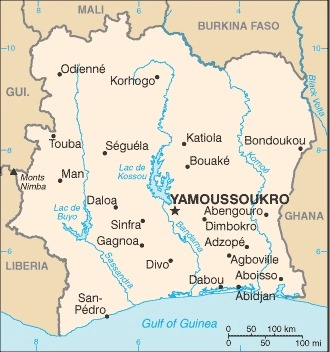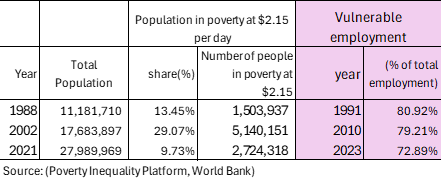
Cote D'Ivoire
Country Flag Details three equal vertical bands of orange (hoist side), white, and green; orange symbolizes the land (savannah) of the north and fertility, white stands for peace and unity, green represents the forests of the south and the hope for a bright future
note: similar to the flag of Ireland, which is longer and has the colors reversed – green (hoist side), white, and orange; also similar to the flag of Italy, which is green (hoist side), white, and red; design was based on the flag of France.
Background
Close ties to France after independence in
1960, the development of cocoa production
for export, and foreign investment have all
made Cote d’Ivoire one of the most
prosperous of the West African states. A
series of coups and conflicts since the 1990s disrupted the country’s political system, but stability returned with the 2021 elections.

Geography
Area
total : 322,463 sq km
land: 318,003 sq km
water: 4,460 sq km
Climate
tropical along coast, semiarid in far north;
three seasons – warm and dry (November to March), hot and dry (March to May), hot and wet (June to October)
Natural resources
petroleum, natural gas, diamonds,
manganese, iron ore, cobalt, bauxite,
copper, gold, nickel, tantalum, silica sand,
clay, cocoa beans, coffee, palm oil,
hydropower
People and Society
Population
total: 29,981,758
Ethnic groups
Akan 38%, Voltaique or Gur 22%, Northern
Mande 22%, Kru 9.1%, Southern Mande
8.6%, other 0.3% (2021 est.)
LanguagesFrench (official), 60 native dialects of which Dioula is the most widely spoken
Religions
Muslim 42.9%, Catholic 17.2%, Evangelical
11.8%, Methodist 1.7%, other Christian
3.2%, animist 3.6%, other religion 0.5%,
none 19.1% (2014 est.)
Population growth rate
2.13% (2024 est.)
Government type
presidential republic
Capital
name: Yamoussoukro (legislative capital), Abidjan (administrative and economic capital); note – the US Embassy is in Abidjan
Executive branch
chief of state: President Alassane Dramane OUATTARA (since 4 December 2010)
head of government: Prime Minister Robert BREUGRE MAMBE (since 17 October 2023)
Economy
Real GDP (purchasing power parity)
$202.119 billion (2023 est.)
$190.319 billion (2022 est.)
$179.178 billion (2021 est.)
Real GDP per capita
$6,500 (2023 est.)
$6,300 (2022 est.) $6,000 (2021 est.)
Exports
$17.211 billion (2022 est.)
$16.23 billion (2021 est.)
$13.232 billion (2020 est.)
Exports – partners
Switzerland 17%, Netherlands 9%, Mali 7%,
USA 5%, Malaysia 4% (2023)
Exports – commodities
gold, cocoa beans, rubber, refined
petroleum, coconuts/brazil nuts/cashews
(2023)
Imports
$19.948 billion (2022 est.)
$16.191 billion (2021 est.)
$12.66 billion (2020 est.)
Imports – partners
China 16%, Nigeria 12%, France 6%, India
5%, USA 4% (2023)
Imports – commodities
crude petroleum, ships, refined petroleum,
fish, rice (2023)

Export structure by product group in 2023 (% of total export)(UNCTAD)
The export structure of a country encompasses the variety, composition, and value of its goods and services traded internationally, offering crucial insights into the nation’s economic vitality, competitiveness, and stage of development. In the case of Cote d’Ivoire, its export composition highlights Côte d’Ivoire’s reliance on agricultural commodities, particularly cocoa and cashew nuts, while also emphasizing the growing significance of the mining and energy sectors in its economy. This structure not only shapes Cote d’Ivoire’s trade relationships but also affects its resilience and adaptability in the ever-evolving global market.

Poverty and Vulnerable employment (World Bank)
Understanding the poverty level at $2.15
In 2021, nearly 10 percent of the population in Cote d’Ivoire lived in poverty at $2.15 per day. The poverty level at $2.15 per day (measured in 2017 purchasing power parity, or PPP) is a key global benchmark used by the World Bank to define extreme poverty in low-income countries. It indicates:
1. Basic Survival Threshold
• People living below $2.15 per day struggle to afford essential needs such as food, clean water, shelter, healthcare, and education.
2. Economic Underdevelopment
• A high percentage of a country’s population living below this threshold suggests low economic productivity, high unemployment, and weak social safety nets.
3. Inequality and Social Vulnerability
• It reflects deep income inequality and a lack of access to opportunities for upward mobility.
• People in this category are more vulnerable to shocks like food price increases, climate disasters, or health crises.
4. Policy Challenges
• Governments need targeted interventions such as social welfare programs, job creation, and improved access to education and healthcare to reduce poverty.
A country's export structure is a reflection of its level of development and its productive capacities
The export structure of a country refers to the composition, diversity, and value of the goods and services it sells to other countries. It provides key insights into the country’s economic health, competitiveness, and level of development. Productive capacities of a country refer to its ability to produce goods and services efficiently and sustainably over time. These capacities are shaped by various factors, including human capital, natural resources, infrastructure, private sector, development, technology & innovation, institutions & governance, financial systems trade & market access.
Here’s what the export structure and productive capacities of a country typically indicate:
- Level of Economic Development
- Developed economies usually export high-value manufactured goods, technology, and services.
- Developing economies often rely on raw materials, agricultural products, or low-value manufactured goods.
- Industrial and Sectoral Strengths
- A strong presence of high-tech or industrial goods (e.g., machinery, electronics) suggests a well-developed manufacturing sector.
- A dominance of commodities (e.g., oil, minerals, agricultural products) indicates reliance on natural resources.
- Export Diversification
- A diverse export base (multiple industries) makes a country’s economy more stable and resilient to global price shocks.
- A concentrated export base (few key products) makes it vulnerable to market fluctuations.
- Trade Partnerships and Dependence
- If exports are heavily dependent on a single country or region, the economy is more exposed to geopolitical and trade risks.
- A wide range of trading partners indicates stronger global integration.
- Competitiveness and Value Addition
- Exporting mainly raw materials (e.g., crude oil instead of refined petroleum) suggests limited industrial processing capacity.
- A high share of finished and high-tech goods suggests strong value addition and competitiveness.
Cote d’Ivoire-Sanitation
Cote d’Ivoire – Proportion of population served with at least basic sanitation services
In 2022, proportion of population served with at least basic sanitation for Cote d’Ivoire was was 37 %. Proportion of population served with at least basic sanitation of Cote d’Ivoire increased from 20.7 % in 2000 to 37 % in 2022 , an absolute change of 16.3 percentage points (pp) between 2000 and 2022.
Cote d’Ivoire – Proportion of urban population served with at least basic sanitation
In 2022, proportion of urban population served with at least basic sanitation for Cote d’Ivoire was 50.7%. Proportion of urban population served with at least basic sanitation of Cote d’Ivoire increased from 38.3 % in 2000 to 50.7 % in 2022, an absolute change of 12.4 pp between 2000 and 2022.
Cote d’Ivoire – Proportion of rural population served with at least basic sanitation
In 2022, proportion of rural population served with at least basic sanitation for Cote d’Ivoire was 21.7 %. Proportion of rural population served with at least basic sanitation of Cote d’Ivoire increased from 7.3 % in 2000 to 21.7 % in 2022, an absolute change of 14.4 pp between 2000 and 2025.
Cote d’Ivoire – People using at least basic sanitation services (% of population): A Global Perspective
Cote d’Ivoire is grappling with a significant sanitation crisis, as only 37 percent of its population had access to basic sanitation facilities in 2022, despite a notable increase from just 20.7 percent in 2000. This still poses a considerable challenge for public health and quality of life within the nation. In stark contrast, nations like Vietnam, South Korea, and Thailand have made substantial strides, boasting nearly universal access to essential sanitation services. This disparity highlights the ongoing struggles that vulnerable communities across Sub-Saharan Africa continue to endure, emphasizing the urgent need for concerted efforts and investments to improve sanitation infrastructure and services in the region.

Cote d’Ivoire – Proportion of rural population with at least basic sanitation services (% of rural population) : A Global Perspective
In the chart below, we illustrate the proportion of the rural population in Cote d’Ivoire with access to at least basic sanitation services, emphasizing a vital aspect of public health and well-being. As of 2022, 21.7% of the rural population benefited from basic sanitation facilities, representing a significant increase from just 7.3% in 2000. But countries like Thailand, and Malaysia had nearly achieved universal access, approaching 100% in 2022. These disparities not only affect public health outcomes but also impede the development of the most vulnerable communities across Sub-Saharan Africa, underscoring the urgent importance of addressing these issues within the framework of global sustainability initiatives.

Cote d’Ivoire -Water Supply
Côte d’Ivoire – Proportion of total population served with at least basic water
In 2022, proportion of population served with at least basic water for Côte d’Ivoire was 72.9 %. Proportion of population served with at least basic water of Côte d’Ivoire increased from 70.6 % in 2000 to 72.9 % in 2022 an absolute change of 2.3 pp between 2000 and 2022.
Cote d’Ivoire – Proportion of urban population served with at least basic water
In 2022, proportion of urban population served with at least basic water for Côte d’Ivoire was 86.2 %. Proportion of urban population served with at least basic water of Côte d’Ivoire fell gradually from 90.9 % in 2003 to 86.2 % in 2022, an absolute change of 4.7 pp between 2003 and 2022.
Cote d’Ivoire – Proportion of rural population with at least basic water
In 2022, proportion of rural population served with at least basic water for Côte d’Ivoire was 58 %. Proportion of rural population served with at least basic water of Côte d’Ivoire increased from 55.3 % in 2000 to 58 % in 2022, an absolute change of 2.7 pp between 2000 and 2022.
Côte d’Ivoire – Proportion of total population with access to at least basic drinking water: A Global perspective
Cote d’Ivoire continues to grapple with significant challenges surrounding access to safe drinking water, a basic human necessity and an essential right that must be guaranteed for every individual. As of 2022, only 72.9 percent of the population had access to at least basic water facilities, reflecting a modest improvement from 70.6 percent in 2000. This progress starkly contrasts with the impressive situation in countries like South Korea and Thailand, where 100 percent of the population enjoyed safe drinking water in the same year. The disparities not only highlight the urgent need for increased efforts and investments but also emphasize the crucial importance of ensuring that all citizens of Cote d’Ivoire access this vital resource for their health, well-being, and overall quality of life, fostering a more equitable future for all.

Côte d’Ivoire – Proportion of rural population served with at least basic water: A Global Perspective
In 2022, it was deeply concerning to note that only 58% of the rural population in Cote d’Ivoire had access to essential drinking water facilities, highlighting the significant challenges that many individuals encounter in securing this vital resource for their daily lives. This situation stands in stark contrast to the remarkable achievements of Bangladesh and Thailand, where nearly 100% of their rural populations have already enjoyed access to safe drinking water. These glaring differences not only underscore the urgent need for comprehensive strategies to improve water access for vulnerable communities across Sub-Saharan Africa but also emphasize the importance of a collective effort to ensure that all individuals can benefit from this essential commodity to foster a future in which everyone has the same opportunity to thrive.

Cote d’Ivoire-Access to Electricity
Cote d’Ivoire-Access to Electricity (% of population)
In 2022, proportion of population with access to electricity for Cote d’Ivoire was 70.4 %. The proportion of population with access to electricity of Cote d’Ivoire increased from 43.6% in 2000 to 70.4% in 2022, an absolute change of 26.8 pp between 2000 and 2022.
Cote d’Ivoire-Access to Electricity (% urban population)
In 2022, proportion of urban population with access to electricity for Cote d’Ivoire was 95%. The proportion of urban population with access to electricity of Cote d’Ivoire increased from 81.6% % in 2000 to 95% in 2022, an absolute change of 13.4 pp between 2000 and 2022.
Cote d’Ivoire-Access to Electricity (% rural population)
In 2022, proportion of rural population with access to electricity for Cote d’Ivoire was 45.3 %. The proportion of rural population with access to electricity of Cote d’Ivoire increased from 19.3 % % in 2000 to 45.3% in 2022, an absolute change of 26 pp between 2000 and 2015.
Cote d’Ivoire- Population with access to electricity (% of total population): A Global Perspective
In 2022, Cote d’Ivoire’s electricity access rate was reported to be 70.4 percent, which indicates that a significant portion of nearly 30 percent of the population still lives without this crucial service, underscoring the ongoing challenge of energy distribution in the country. In stark contrast, nations such as Vietnam, Sri Lanka, and Indonesia have made remarkable progress in providing universal electricity access to their citizens during the same year, demonstrating a commitment to improving the quality of life and fostering economic development through enhanced energy availability.

Cote d’Ivoire- Rural population with access to electricity (% of rural population): A Global Perspective
The chart below reveals a significant disparity in electricity access between Cote d’Ivoire and other developing nations, highlighting the urgent need for major enhancements in energy infrastructure. In 2022, only 45.3% of the rural population in Cote d’Ivoire had electricity access, exposing ongoing developmental challenges. In contrast, countries such as Vietnam, Thailand, and Sri Lanka achieved 100% electricity access for their rural communities during the same timeframe. This disparity underscores the critical necessity for improved energy solutions in Cote d’Ivoire and illustrates the essential role that dependable electricity plays in promoting sustainable development and improving living standards for rural populations.

Cote d'Ivoire-Health Outcomes
Cote d’Ivoire- Life expectancy
Cote d’Ivoire has experienced minimal improvement in life expectancy over the past seventy years, a period during which the global average has significantly increased, enabling many individuals to live longer and healthier lives. In 1950, the worldwide average life expectancy for newborns stood at just 47 years, but by 2022, it had risen to an impressive 71 years. In contrast, Cote d’Ivoire has seen only a slight increase in life expectancy, moving from 38 years in 1960 to 59 years in 2022. This stands in sharp contrast to countries like South Korea, which witnessed an extraordinary increase from only 21 years in 1950 to an impressive 83 years by 2021. Similarly, the Maldives made notable improvements, with life expectancy rising from 39 years in 1960 to a remarkable 81 years in 2022, illustrating the uneven effects of healthcare progress and socio-economic development across different regions

Cote d’Ivoire- Maternal mortality ratio (per 100,000 live births) : A Global Perspective
The following chart provides a sobering overview of the annual incidence of pregnancy-related fatalities, categorized by region and country, highlighting the alarming reality that a substantial majority of these tragic deaths occur in Sub-Saharan Africa. This pressing issue is intricately linked not only to the significantly higher birth rates in this region but also to the persistently elevated maternal mortality rates that continue to challenge healthcare systems across these countries. For example, in Cote d’Ivoire, the number of maternal deaths rose from 473 in 2000 to 480 in 2020, indicating a troubling stagnation in progress toward improving maternal health. Conversely, Bangladesh has made remarkable strides in reducing its maternal mortality ratio, which plummeted from 441 in 2000 to 123 in 2020, showcasing the positive impact of targeted health interventions. Similarly, India has also witnessed substantial advancements, with its maternal mortality rate decreasing from 384 in 2000 to 103 in 2020, serving as a compelling testament to the potential for improved maternal health outcomes when adequate resources and effective policies are put into place.

Cote d’Ivoire- Mortality rate, under-5 ( per 1000 live births): A Global Perspective
Since 1950, child mortality rates around the globe have experienced a remarkable decline, primarily driven by enhancements in living standards, healthcare access, nutritional quality, and the availability of safe drinking water. In the most affluent nations of Europe and America, child mortality has plummeted to less than four percent, showcasing the success of these improvements. Over the past seven decades, numerous developing countries across South America, Asia, and Africa have also achieved significant progress in reducing child mortality rates. However, it is important to note that the pace of advancement has been notably slower in many Sub-Saharan African nations. For instance, in Cote d’Ivoire, the under-five mortality rate saw a decrease from 169 per 1,000 live births in 1980 to 69 in 2022. In comparison, Bangladesh made an impressive reduction in its under-five mortality rate from 206 in 1980 to just 29 in 2022, while India similarly improved its rate from 121 in 1980 to 21 in the same year, highlighting the varying trajectories of progress across different regions.
